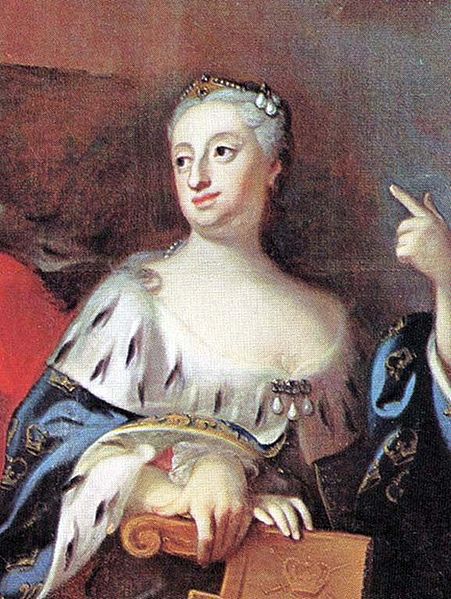<Back to Index>
- Mathematician David Hilbert, 1862
- Architect Auguste de Montferrand, 1786
- Queen of Sweden Ulrika Eleonora, 1688

Ulrika Eleonora (23 January 1688 – 24 November 1741), also known as Ulrika Eleonora the Younger, was Queen regnant of Sweden from 30 November 1718 to 29 February 1720, and then Queen consort until her death.
She was the youngest child of King Charles XI and Queen Ulrika Eleonora the Elder and named after her mother. After the death of her brother King Charles XII in 1718, she claimed the throne over the rights of her nephew Charles Frederick, Duke of Holstein-Gottorp, the only son of her late elder sister, on basis of being the closest surviving relative of the deceased king (the idea of proximity of blood) and the precedent of Queen Christina,
though not his heiress in primogeniture. The succession discussions
ultimately ended in her favour after she had agreed to abolish the absolute monarchy. She abdicated the Swedish throne in 1720 and was succeeded by her consort, Landgrave Frederick I of Hesse-Kassel. A princess and spinster, she took care of her dominating grandmother, Hedwig Eleonora of Holstein-Gottorp, during her brother's absence in the Great Nordic War. During this period, her older sister, Princess Hedvig Sophia of Sweden,
Duchess of Holstein-Gottorp, was the heir to the throne. Her situation
began to change after the death of her older sister in 1708. As her
brother refused to marry, and as she was the only royal representative
in Sweden, she was in 1713 named as regent during the king's absence by
the government and by her grandmother, and thus became the puppet to
many powers struggling for influence in a country without a real heir.
The choice now stood between Princess Ulrika Eleonora and her nephew,
her older sister's son, the duke of Holstein-Gottorp. Her accession as
regent and president of the parliament was treated with great
enthusiasm. The parliament was in opposition to her brother as they
wanted to abolish the absolute monarchy and reinstate the power of the
parliament. After
her grandmother's death in 1715 she became the center of the court, and
this was most likely one of the most happy periods of her life. It was
during this period, in the year of 1715, that she married Landgrave Frederick I of Hesse-Kassel, but
the marriage, which on her side was a marriage of love, was to be but
another one of the many attempts to use her as a political puppet. Her
husband had married her with the intent to reach the throne through
her, and immediately started to work to get her appointed as heir to
the throne before her nephew, and the "Hesse-party" and the
"Gottorp-party" stood against each other in the struggle to the throne.
When her brother the king was killed in 1718, the "Hesse-party", as
they were called, secured Ulrika Eleonora's succession to the throne
before her nephew, the duke of Holstein-Gottorp. They managed to secure
the support of the opposition, who wanted to abolish the absolute monarchy from
1680 and reinstate the rule of the parliament. Her reign took place in
the middle of the last years of the Great Nordic War. In
her accession, she had to give her consent to a new constitution, which
greatly limited the power of the monarch, to accomplish this.
Thereafter, she was formally elected monarch and crowned in Uppsala in March 1719. She
was strongly in favor of an absolute monarchy, and had agreed to the
new constitution only to secure the throne from her nephew. She
supported her husband's political ambitions and wanted him to become
co-regent, following the example of King William III of England and Queen Mary II of England,
but this was not permitted by the parliament, as co-reigning had been
forbidden in Sweden since the 15th century, and she therefore abdicated
in his favour after just one year of her reign, which succession was
confirmed by the Riksdag of the Estates.
She often talked about her abdication as the great sacrifice of her
life. Frederick thereafter succeeded her on the Swedish throne as King Frederick I in 1720. Ulrika Eleonora had married for love and was known to be fiercely loyal to Frederick. His
extramarital affairs increased after he lost his real power as a king.
At least until 1724, the Queen expressed the hope that she would give
birth to an heir. In 1730, her spouse became the first king in Swedish
history to have an official mistress, the young noble Hedvig Taube,
who was given the title countess of Hessenstein. The Queen's reaction
to this has never been known and she never commented on it but did retire to religion and charity, although she was made official regent of Sweden during the absence of her spouse on two occasions: in 1731 and in 1738. Queen Ulrika Eleonora died of smallpox in
1741 after a childless marriage. The succession thereafter was marked
by recurring plotting. The reigns of Ulrika Eleonora and her husband
saw the birth of the era of Swedish history traditionally known as the Age of Liberty, when the monarch had to give up most of his power to the aristocracy.